Essential Guide to Choosing the Best Cage Bird Feeders


Intro
Cage bird feeders serve as the backbone of nutrition for our feathered friends. The right feeder not only supplies essential sustenance but also shapes the living experience of pet birds. This guide will unpack the various types of feeders available, weigh their pros and cons, and offer insights that can make a noticeable difference in your bird’s health and happiness. We will navigate through critical themes such as material choices, upkeep routines, effective placement, and the design impact on bird behavior. Along the way, we aim to equip both novice and seasoned avian handlers with the knowledge needed to create the best feeding environments for their cherished companions.
Care Tips
Proper care is integral in maintaining a healthy feeding routine for your birds. Here are a few areas worth considering:
Daily Care Routines
Every single day, it's essential to check the feeders. Refresh water and inspect food levels. A full feeder means happy birds; however, don’t wait for it to run low before refilling it. Birds thrive on routine.
Cage Setup and Maintenance
When arranging the cage, think about the feeder's location. Try to position it where birds can eat comfortably, away from high traffic spots. Regularly assess the feeder’s condition. Any cracks or wear should signal replacement or repair.
Hygiene and Cleaning Practices
Maintaining cleanliness in feeding areas is crucial. Bacteria can grow quickly in leftover food or wet spots. Clean feeders with warm, soapy water at least once a week. It’s also wise to rinse them well to eliminate any soap residue that could harm your birds.
Seasonal Care Adjustments
The seasons bring different challenges. In the warmer months, food can spoil faster. Opt for smaller portions during the heat, ensuring they don’t linger long enough to go bad. Conversely, during colder months, make sure there’s enough readily available food, as birds might need additional energy to maintain their body heat.
Behavioral Insights
Understanding your birds' body language can unveil unspoken messages that indicate their happiness or distress.
Understanding Bird Body Language
Birds communicate their feelings through body posture and vocalizations. Puffing up their feathers might mean they are feeling threatened or cold, while a relaxed stance does usually indicate comfort.
Common Behavioral Issues and Solutions
Many birds may exhibit signs of boredom or stress. Look for feather-plucking or excessive squawking. Rotating toys and introducing new feeding activities can help alleviate these issues.
Positive Reinforcement Techniques
Rewarding good behavior builds trust. If your bird uses the feeder appropriately, a gentle praise or treat reinforces that behavior.
Social Interaction Needs
Birds are social creatures. Ensuring they have time with others—be it humans or other birds—can significantly enhance their mood and behavior. Regular social interaction aids in preventing depression.
Nutrition Guides
Feeding isn’t just about putting seeds in a bowl. It’s a deliberative process that can affect your bird's health profoundly.
Essential Diet Components
A proper diet typically includes seeds, pellets, fruits, and veggies. Each ingredient contributes to different nutritional needs, and a balance is necessary for optimal health.
Safe and Toxic Foods
Familiarize yourself with safe foods for your birds. Always steer clear of toxic ingredients like chocolate, avocados, and caffeine. These can be hazardous, even in small quantities.
Supplements and Treats
Occasional supplements can benefit your birds. Calcium and vitamin-rich treats boost health and keep your feathered friends active.
Feeding Strategies for Different Species
Not all birds eat alike. Parakeets may thrive on a different mix than cockatoos. It’s crucial to adjust the routine based on the bird species to cover all their dietary needs.
A well-balanced diet is vital for your birds' long-term health and vitality. Address their specific needs meticulously to ensure they live a fulfilling and healthy life.
Wellness and Health
Routine health checks and a keen eye for symptoms can help in ensuring your birds remain healthy and happy.
Routine Health Checkups
Just like humans, birds need regular vet visits. Find a vet that specializes in avian care. Screening can catch problems before they become serious.
Identifying Symptoms of Illness
Learn the signs of common illnesses, like changes in droppings or lethargy. Know what normal looks like to act swiftly if something appears amiss.
Preventative Care and Vaccinations
Ensure vaccinations are up to date, especially in regions where certain diseases are common. Preventative measures are always better than dealing with consequences later.
Mental and Emotional Well-being
Creating a stimulating environment affects mental health. This entails plenty of interaction and engagement alongside nutrition.
Enriching Activities
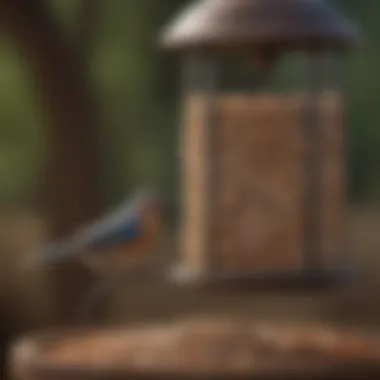
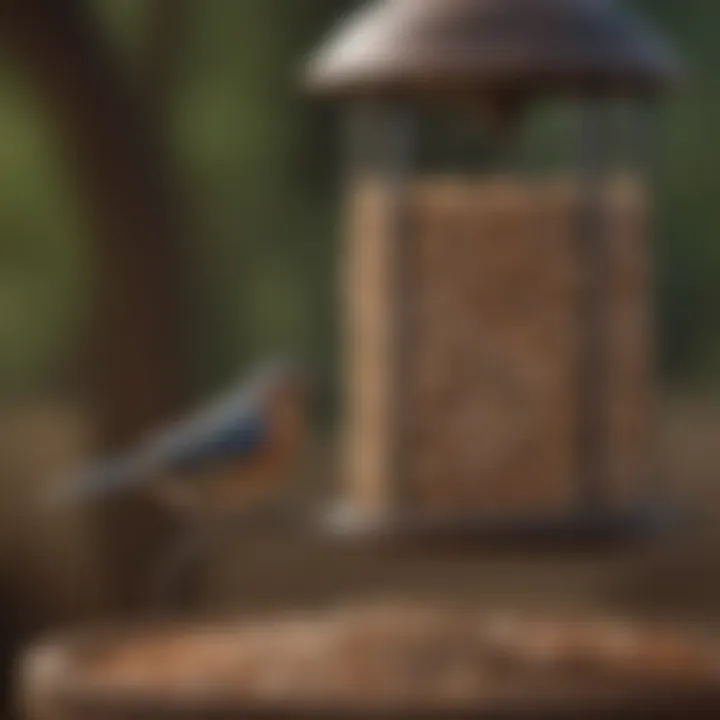
Birds need more than just food and water. Enrichment is essential.
Toys and Playtime Ideas
Toys made of different materials keep birds engaged. Rotate toys periodically to maintain their interest.
Training and Tricks
Bird training can be a rewarding experience that enhances the bond between the bird and its owner. Simple commands or tricks create interaction and entertainment.
Outdoor Activities and Interaction
If weather permits, consider supervised outdoor time. Fresh air can be revitalizing, and outdoor sights often intrigue birds.
DIY Projects for Mental Stimulation
Crafty projects—creating toys or perches—can stimulate both your creativity and your bird’s curiosity. Simple DIY elements add a nice personal touch to their environment.
In summary, investing time and consideration into every aspect of your bird's care greatly influences their wellbeing and enjoyment. Adapting the feeding approach and the surrounding environment fosters not only proper health but also a bond that flourishes over time.
Understanding Cage Bird Feeders
Cage bird feeders are not just a convenience for pet bird owners, they're essential tools for ensuring the health and well-being of their feathered companions. Understanding these feeders plays a crucial role in keeping birds nourished and happy. With a myriad of options available, it's vital to recognize the specific functions and features that cater to the diverse dietary needs of different avian species. The right type of feeder not only promotes better feeding habits but also enhances the overall living environment for birds.
Bird feeders offer a means to provide essential nutrients, and birds naturally gravitate towards food sources that mimic their wild counterparts. This inclination helps stimulate their instincts, encouraging natural behaviors such as foraging and exploring. Familiarizing oneself with various feeder types promotes an enlightened approach to avian care that can positively influence a bird’s physical and mental health.
The Purpose of Bird Feeders
Feeding birds properly serves multiple purposes—primarily, it fulfills the nutritional requirements of captive birds. Proper diet can lead to vibrant plumage, energy for active behavior, and even longevity. However, it extends beyond mere sustenance. Feeders can create opportunities for birds to engage socially with each other, thus fostering a sense of community.
Types of Feeders Available
Bird feeders come in several varieties, each suited for different feeding styles or bird types. The most commonly used types include:
- Seed Feeders: These feeders are designed to dispense various seeds, which are the staple diet for many birds. They typically maintain a consistent flow of seeds, allowing birds to eat freely without overcrowding.
- Hopper Feeders: With a design resembling a small house, hopper feeders can hold a decent amount of seeds and allow various birds to gather at once. They tend to be popular due to their versatility in size and shape.
- Platform Feeders: These feeders provide a flat surface for birds to feed directly, making them easily accessible. They can attract a wide variety of birds but come with some challenges regarding weather exposure and cleanliness.
- Tube Feeders: These narrow, vertical feeders accommodate different seed types in their compartments. Designed to deter larger birds from accessing the food, they encourage smaller bird varieties to feed comfortably.
Seed Feeders
Seed feeders, found in countless styles and designs, are indeed the workhorses of bird feeding. They often come with multiple feeding ports, allowing several birds to dine simultaneously. A notable feature is their durability—most are designed to withstand various weather conditions, ensuring a stable food supply. While offering an excellent feeding experience, one drawback might be the types of birds they attract, sometimes favoring only those who prefer seeds.
Hopper Feeders
Hopper feeders are a standout choice for their ability to store significant amounts of feed, making them less prone to frequent refills. A common characteristic is the protective roof, ensuring seeds remain dry. However, they can become a bit cumbersome to clean, and if not used properly, seeds might spoil.
Platform Feeders
Platform feeders sit flat and open, providing a direct feeding experience. One significant advantage is their ability to accommodate multiple bird species simultaneously. However, the downside is that they often need regular cleaning due to seeds and waste accumulating—especially in rainy weather, which can render the feed soggy.
Tube Feeders
Tube feeders exhibit a sleek and space-efficient design, targeting small birds typically found in suburban areas. Often, they incorporate features designed to keep out larger species, promoting a peaceful feeding space for finches, sparrows, and other small birds. Nonetheless, ensuring the feeder is cleaned and refilled is essential to deter mold and seed spoilage, which can adversely affect birds' health.
Thus, understanding the myriad of feeder types available is integral for any bird owner intent on creating an enriching and supportive environment for their avian friends. Who knew a little knowledge about feeders could go a long way? Given the myriad of options, ensuring you choose the right type can elevate not just your bird's quality of life but also your satisfaction as a pet owner.
Material Matters: Choosing the Right Feeder
When it comes to cage bird feeders, the material from which they are made carries significante implications for both the birds and their caregivers. The choice of material can influence durability, maintenance, and even the overall bird-feeding experience. Understanding these aspects helps bird owners select a feeder that not only meets their aesthetic preferences but also serves the practical needs of their feathered friends.
Plastic vs. Metal vs. Wood
Bird feeders can vary widely in material—each with its own set of pros and cons. Plastic feeders are lightweight and often cheaper, making them an accessible option for many. However, they risk getting brittle over time, especially under the harsh conditions of sunlight or extremes of temperature. You wouldn’t want to invest in something that can crack like a shell under pressure, would you? They are also often easier to clean and can be molded into various shapes, appealing to the creativity of bird owners.
Metal feeders, like those made from stainless steel or aluminum, offer a sturdier solution. They resist wear and tear better than plastic, thus lasting much longer. But let's not sugarcoat it, they can be heavier and pricier. When looking to invest in a metal feeder, ensure it has no sharp edges that could injure birds.
Wooden feeders bring a traditional aesthetic to bird care. They blend beautifully with nature and can be quite charming. Yet, their durability is often a mixed bag. If untreated, wood is vulnerable to rot and insect infestation. Some might argue that maintaining a wooden feeder can be a labor of love, requiring careful upkeep to protect against decay.
In weighing these options, consider the environment and the types of birds you aim to attract. Different materials might appeal to different species, serving as an involuntary marketing tactic for the birds.
Durability and Maintenance
Durability is not just a fancy term thrown around; it's at the heart of your investment. A feeder may look cute and fancy, but if it can’t stand the test of time, you might as well throw your money down the drain.
- Plastic feeders: These often require less maintenance in terms of cleaning, but the longevity can be lacking. A cracked pathos can lead to a far less inviting environment for birds. You might also find yourself replacing these more frequently, which can become a hassle.
- Metal feeders: They generally score high on durability. These feeders can withstand some serious weather and occasional rough handling. Cleaning is necessary, but the good news is that metal is less prone to harbor microorganisms. However, be wary of rust if not properly coated.
- Wooden feeders: While their charm can be hard to resist, they demand attention. Regular inspection for signs of rot or woodpecker damage is crucial. Treating them with bird-safe sealants can extend their life significantly. The maintenance needed can feel overwhelming; however, it's a small price for the beauty they bring.
All things considered, the choice you make when selecting a feeder's material largely hinges on your personal preferences, the birds you nurture, and the level of care you're willing to provide. Choosing wisely can significantly impact both the aesthetics of your bird care setup and the health of your feathered companions.
Remember, a feeder serves as more than a feeding station; it’s a vital resource in ensuring the health and vitality of your avian friends.
Analyzing Feeding Mechanisms
Understanding the various feeding mechanisms is crucial when selecting the right bird feeder. It’s more than just about convenience; it directly impacts the birds’ feeding behavior, health, and overall enjoyment. Different mechanisms cater to distinct species and environments. When avian owners grasp these mechanisms, they can facilitate a more enriching experience for their feathered friends while potentially reducing waste and mess.
Gravity-Feed Systems
Gravity-feed systems are among the simplest and widely used feeding mechanisms for bird feeders. This design relies on the natural force of gravity to dispense food as birds peck at it. Typically, these feeders have a hopper or container from which the seeds or pellets flow downwards into feeding ports.
Benefits:
- Low maintenance: They are easy to refill and often require minimal upkeep.
- Constant supply: Gravity-fed feeders ensure a consistent supply of food as long as they are filled properly.
- Versatility: Many designs work for various seed types, making them adaptable to different feeding requirements.
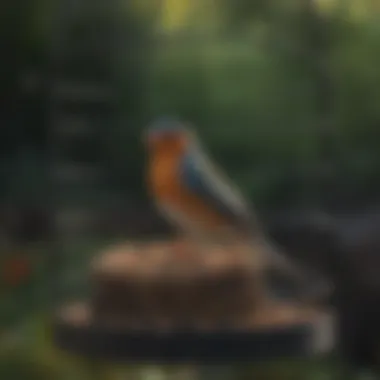
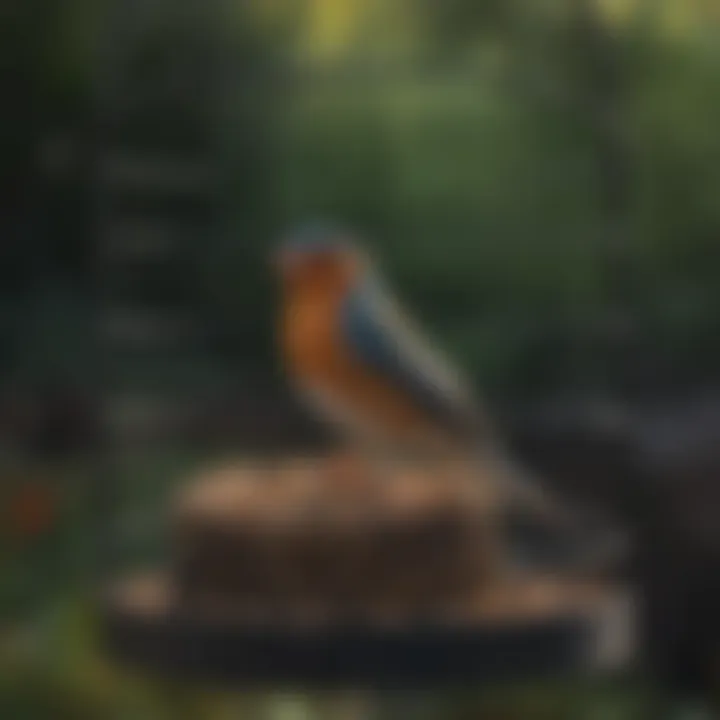
Nevertheless, there are considerations. Over time, seeds can become stale or contaminated if left too long. It's important for owners to monitor the feeder regularly and remove any old food. The design also needs to prevent larger birds from completely crowding out smaller ones.
Suction Feeders
Suction feeders offer a unique way to provide food to cage birds, especially for those with limited space. This type of feeder attaches directly to the glass or bars of the cage using suction cups, making it particularly useful for smaller birds.
Benefits:
- Space-saving: They don’t take up extra floor space in the cage, allowing for more room for the birds to move around and explore.
- Easy to observe: Ideal for bird owners who wish to keep a close eye on feeding habits since these feeders are often placed at eye level.
- Preventing spills: Suction feeders tend to minimize mess, keeping the cage cleaner than traditional designs.
However, one must ensure that the suction cups are secured well. If they lose grip, the feeder could drop, potentially injuring the birds or spilling food. Regular checking is necessary to maintain their effectiveness.
Automatic Feeders
Automatic feeders introduce a level of convenience that is appealing to many bird owners. These devices can dispense a set amount of food at specific intervals, taking the guesswork out of feeding schedules.
Benefits:
- Consistent feeding: Automatic feeders ensure that birds receive food at regular times, beneficial for establishing a routine.
- Feeding control: Owners can monitor portions to prevent overfeeding, which is an essential aspect in maintaining their birds' health.
- Convenience: These feeders can be particularly helpful for owners who may be away from home for extended periods.
On the flip side, these feeders may require batteries or electricity, and there’s a risk of malfunction, which could lead to birds not getting fed when they need it. It’s wise for owners to have a backup plan, perhaps incorporating other feeder types, to ensure a continuous feeding experience.
To summarize, knowing the different feeding mechanisms allows bird owners to select the right feeder for their pets, enhancing their nutrition and general well-being. Taking the time to analyze these options pays dividends in the long-run satisfaction and health of pet birds.
Feeder Design: Influencing Bird Behavior
The design of bird feeders is not just a matter of aesthetics; it can significantly affect the behavior, health, and even the temperament of pet birds. A well-thought-out feeder design fosters a feeding environment that is not only safe but also encourages natural instincts. In this section, we will explore how different feeder designs impact various bird species and how they can enhance their overall well-being.
Accessibility for Different Species
Feeder design must consider the specific needs of various bird species, as they differ widely in size, beak shape, and feeding behaviors. For instance, larger birds like African Greys require wider access points and deeper feeders that can accommodate their beaks. On the other hand, small finches thrive in more confined spaces.
Here are some key considerations:
- Feeder Height: Ensure that smaller birds can easily access the feeder. Placing it closer to the bottom of the cage can be key—like giving a short ladder to a climber.
- Seed Type: Different species prefer different types of seeds. For example, lovebirds may enjoy fine seeds, while cockatiels prefer larger sunflower seeds. The feeder design should allow room for various seed types without leading to waste.
- Perches: Adequate perch space around the feeder not only enhances accessibility but also gives birds a comfortable spot to eat. Birds prefer to perch securely while dining—think of it as their personal dinner table.
By carefully considering these aspects, you can create an area that caters to your bird’s individual needs and ensures they’re comfortably fed.
Encouraging Natural Foraging
Natural foraging behavior is quintessential to avian health, replicating how birds would seek out food in the wild. Feeders designed to mimic this experience can make a world of difference.
Here’s how you can design feeders to enhance foraging:
- Hiding Food: Use feeders that have compartments or wrappings where food can be hidden. This stimulates curiosity and encourages birds to work for their meals, tapping into their instinctual behavior. It’s like giving them a treasure hunt!
- Movement and Interaction: Certain feeders allow movement—like swing feeders—that require the birds to move and release seeds while they play. This interaction helps maintain physical health and mental stimulation.
- Multiple Feeding Areas: Installing more than one feeder creates a scenario where birds can explore and forage freely, reducing competition and stress among cage mates. This setup introduces diversity in their feeding habits, similar to a buffet where there are choices galore.
"Feeder design isn't just about looks; it's about creating a friendly habitat that respects the natural instincts of our feathered friends."
Thus, thoughtful feeder design is instrumental in nurturing birds’ natural behaviors, allowing their instincts to flourish while providing a safe and enriching environment. By prioritizing both accessibility and the encouragement of foraging, bird owners can enhance their pets' quality of life, reeled in the essence of who they are and thrive in their surroundings.
Placement Strategies for Optimal Feeding
When it comes to establishing a healthy feeding routine for your pet birds, placement strategies for optimal feeding are far from trivial. Choosing where to place the feeders can have a significant impact on the accessibility of food, the happiness of your birds, and ultimately, their health. By foreseeing certain aspects of feeder placement, you can foster an environment that promotes vitality and good behavior, all while ensuring your feathery companions get their fair share of delicious snacks.
Choosing the Right Location in the Cage
Finding the best spot for feeders within the cage is about more than just convenience; it’s about creating a space that is welcoming and safe for your birds. Ideally, you want to position feeders where your birds feel comfortable eating. This might mean placing them at various heights to cater to species that prefer to eat on higher perches or those that are ground feeders.
- Avoid corners and secluded areas: While your birds might seek refuge in those nooks and crannies, feeding in such locations can lead to stress and reluctance in approaching the food.
- Near perch positions: Placing feeders near their favorite perches can enhance accessibility. Birds are more likely to utilize feeders placed within their flight paths and range of sight.
- Consider visibility: Make sure your birds can see each other while they feed. This visibility can enhance their sense of security when eating.
- Multiple feeders: If you have more than one bird, consider adding multiple feeders to avoid competition, especially among larger breeds that might intimidate the smaller ones.
Establishing a feeding area where birds feel secure can transform an ordinary feeding session into a comfortable feast, contributing to a more relaxed and cheerful environment.
Avoiding Stressful Environments
It’s vital to keep in mind that feeders should be situated in locations that do not induce stress in your birds. Excessive noise, sudden movements, and frightening sights can deter them from approaching their food, making proper placement essential. Here are some guidelines to help you avoid stressors:
- Away from active zones: Avoid placing feeders in areas where there is frequent human activity or a lot of noise. Areas close to loud televisions or busy hallways can create a stressful atmosphere.
- Shielded from household predators: If you have cats or other pets, place feeders in less reachable spots, ensuring your birds don’t feel threatened by potential predators. This can involve physical barriers or simply choosing feeder locations that are elevated out of reach.
- Limit reflections: Birds can be startled by their reflections. Place feeders in positions that minimize mirrored surfaces; this helps in eliminating unnecessary fright.
- Introduce gradual changes: If you need to move a feeder for some reason, do it gradually. Sudden changes in the cage layout can unsettle your birds. Whenever you adjust their environment, provide time for them to adapt before making additional changes.
By thoughtfully analyzing feeder placement and minimizing stressors, you can create a more inviting ecosystem for your birds. Each time they feed in calm and secure settings, not only do they enjoy their meal, but they also thrive in an environment that respects their natural behaviors.
"A well-placed feeder is a gateway to a healthier, happier bird. Experiment and watch how your avian friends respond."
Ultimately, these placement strategies will play a crucial role in the overall feeding success and wellbeing of your cherished companions.
Feeder Maintenance: Keeping It Clean
Maintaining a clean bird feeder is not just an afterthought; it’s a crucial aspect of ensuring the health and well-being of your feathered friends. The feeders serve as the primary source of nourishment for your pet birds, and a dirty feeder can lead to a variety of health issues. In fact, regular maintenance is one of the simplest yet most effective ways to prevent diseases that can spring up from old food remnants and unclean conditions.
Regular cleaning routines help in keeping harmful bacteria and mold at bay. It also makes the feeding environment more inviting for your birds.
Regular Cleaning Routines
Creating a schedule for cleaning your bird feeders is the best way to make sure they are always hygienic and functional. Depending on the type of feeder, a routine might vary, but a good rule of thumb is to clean them at least once a week. Here’s a basic routine you can follow:
- Dump out old food: Every week, start by emptying out any leftover seeds or food. Don't be surprised if you come across some unwanted guests like mold or pests that might have found their way in.
- Wash with soap and water: Use warm soapy water to wash down the feeder. A mixture of vinegar and water can also do wonders. Make sure to scrub all parts to remove any residue.
- Rinse thoroughly: After washing, rinse the feeder under running water to eliminate any soap traces. Birds are sensitive to chemicals, so it's important to ensure that no residue remains.
- Dry completely: Before refilling, allow the feeder to dry completely. Moisture can lead to fungi growth, and we certainly don’t want that.
- Inspect for damage: While cleaning, take a moment to check for any wear and tear. If you find cracks or other damage, think about replacing the feeder.
By establishing a cleaning routine, you not only keep your feeder in top shape, but it also becomes easier to notice any abnormalities that might signal health risks.
Identifying Signs of Contamination
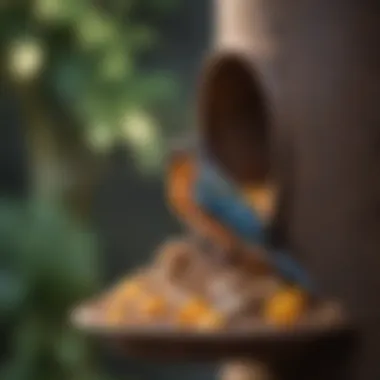
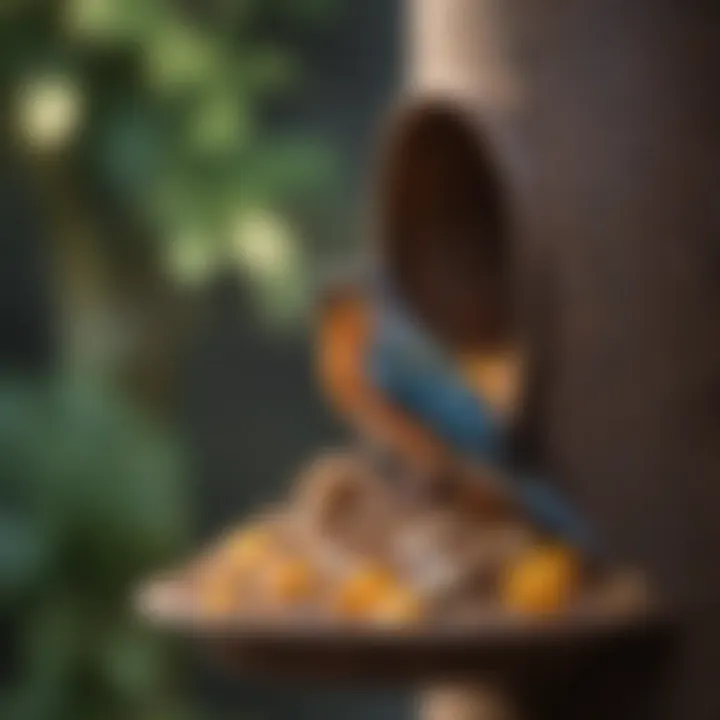
A clean feeder is vital, but it’s just as important to be vigilant about identifying signs of contamination. Ignoring these can quickly turn a feeding station into a health hazard. Here are some red flags to watch for:
- Mold growth: If you spot any fuzzy spots or green patches inside the feeder, that’s a definitive signal that mold has taken root. Birds are particularly susceptible to respiratory illnesses caused by mold spores.
- Foul odors: An unpleasant smell emanating from the feeder is a telltale sign that something isn’t right. It could be spoiled food or even waste buildup, both of which need immediate attention.
- Pest presence: Seeing insects or pests around your feeder should send up alarm bells. Flies, ants, or any other critters are not only unsightly but can also spread diseases.
- Old or discolored food: If the seeds appear old, shriveled, or has changed color significantly, it’s time to give them the boot. Fresh seeds are more appealing and nutritious for your birds.
- Unusual bird behavior: If you notice your birds avoiding the feeder or showing signs of illness—like lethargy or unusual feathers—take a closer look. They might sense something amiss before you do.
"Regular maintenance checks can save you a lot of trouble down the line. It ensures that both the feeder and your birds remain in top condition."
By keeping an eye out for these signs and adhering to a cleaning schedule, you'll create a healthier feeding environment. A clean feeder is critical to supporting not just the birds' appetite, but also their overall health.
Alternative Feeding Options
When it comes to the diet of pet birds, offering just seeds may not cut it. This is where alternative feeding options come into play. These choices are not only about variety but also significantly impact the overall health and happiness of our feathered friends. By diversifying their diet with fruits, vegetables, and even homemade treats, bird owners can provide nutrients that commercial seeds often lack. Here’s a closer look at how these alternatives can support the wellness of cage birds.
Fruit and Vegetable Additions
Incorporating fruits and vegetables into a bird's diet can be a game changers. These natural foods are packed with vitamins, minerals, and fibers that seeds can’t really offer. Birds, much like humans, benefit from a colorful plate. Brightly colored fruits—such as bell peppers, carrots, and berries—are often high in Vitamin A, crucial for maintaining healthy feathers and skin.
When introducing fruits and veggies, it’s essential to consider the following:
- Freshness Matters: Always opt for fresh produce rather than canned or pre-packaged items. Look for organic options when possible to avoid pesticide residues.
- Introduce Gradually: Birds can be picky eaters. Start with small pieces and see what they enjoy. It’s like offering a child new foods. Be patient.
- Safe Choices: Certain foods are toxic to birds. For instance, avocado and chocolate should always be kept away. Make a quick reference list of safe fruits and veggies to guide your choices.
- Presentation Counts: Birds often engage with their food visually. Presenting fruits on a skewer or in a foraging toy can pique their interest.
"Variety is the spice of life." This adage holds true for our avian companions. A mix of foods keeps them active and inquisitive, leading to happier, healthier birds.
Homemade Treats and Mixes
Crafting homemade treats can be both a fun activity and a great way to ensure that your bird gets wholesome nutrition. The advantage of these treats is the ability to control ingredients entirely. You can tailor them to suit the specific taste preferences and dietary needs of your bird.
Creating treats can be as simple or complex as you want. Here are some ideas to consider:
- Baked Bird Cakes: Use whole grains, fruits, and nuts (safe for birds) to whip up a cake. Just mix everything together and bake. This could be a delightful treat on special occasions.
- Seed Mixes: Customize a seed mix with various seeds, nuts, and dried fruits. This can enhance the joy of foraging, and birds will relish the hunt for their favorite pieces.
- Nut Butter Pops: Spread a thin layer of unsweetened nut butter on a piece of fruit and freeze. Birds often enjoy colorful, textured treats that challenge their beaks.
- Fruits and Veggie Purees: Blend safe fruits and veggies and freeze in small portions. Your birds will love the excitement of a frozen treat on especially warm days.
Always keep an eye on how your bird responds to homemade offerings. Some might dive right in, whereas others may take time. It’s all part of the process.
Impact of Feeding on Avian Health
Feeding is more than just filling a bowl; it profoundly influences a bird's well-being, behavior, and overall health. Understanding the impact of what we feed our feathered companions helps ensure their vitality and happiness. The right diet can boost immunity, enhance mood, and even prolong life. On the flip side, poor nutrition can lead to various health issues, making this a critical topic for every bird owner.
Understanding Nutritional Needs
Birds, like any other pets, have specific nutritional requirements. These needs can vary significantly depending on species, age, and health conditions. Generally, a well-balanced diet for birds consists of:
- Seeds: While seeds are a staple, they shouldn't make up the entirety of a bird's diet. Seeds contain fats that may lead to obesity if fed in excess.
- Pellets: These provide a formulated way to ensure birds receive necessary vitamins and minerals that seeds alone might lack.
- Fruits and Vegetables: Fresh produce introduces vital nutrients and hydration. Dark leafy greens like kale and colorful fruits like berries can be game-changers for a bird's diet.
- Proteins: Proteins from cooked eggs, legumes, or insects can support healthy growth and egg-laying in breeding birds.
Understanding these needs helps owners provide a varied and balanced diet. Each bird species has its nuances, which makes consulting a vet or avian expert wisely a substantial step for owners.
Preventing Obesity and Malnutrition
Obesity and malnutrition are two sides of the same coin. Many bird owners unknowingly fall into the trap of overfeeding on seeds, leading to weight issues. Conversely, feeding limited varieties can devastate their health. Here’s how to navigate this:
- Portion Control: Measure daily intake to avoid indulgence and monitor develops in your bird’s weight over time. It's an excellent practice to introduce different types of food gradually. For instance, if your bird is not used to pellets, mix a small amount with their familiar seeds before transitioning fully.
- Regular Vet Check-ups: Routine veterinary visits help catch health issues early. They can also provide tailored advice based on individual needs.
- Engagement with foraging: Encourage natural behavior through foraging opportunities. Hanging greens or mixing seeds in a treat ball keeps birds active and mentally stimulated.
- Educational Forums: Engaging with forums such as reddit.com gives bird owners a platform to share experiences and tips.
"Health is wealth, even in our avian friends. An informed decision about their diet can significantly enhance their quality of life."
Expert Insights and Recommendations
In the intricate world of avian care, knowledge is power. This section illuminates the importance of expert insights regarding bird feeders. Indeed, feeding is not a mere act of scattering seeds. It lays the foundation for a pet bird's overall health and happiness. When you understand that feeding practices can influence behavior, immune responses, and longevity, you realize the gravity of this matter.
Veterinary Perspectives on Feeding
Veterinarians are the unsung heroes in the realm of bird care. Their expertise offers insights into how the right feeder can contribute to a bird’s physical and psychological health. They emphasize that each species has its own dietary needs. For instance, while cockatiels thrive on seed blends, budgies may benefit from a more diverse diet that includes pellets and greens.
"Proper nutrition is paramount for preventing disease in birds. An informed feeder choice can significantly enhance their quality of life," a veterinarian once noted.
When selecting a feeder, it is crucial to ensure that it corresponds with the dietary requirements of your birds. A feeder designed for seed may not accommodate larger pellets or other dietary additions. The nuances of each feeder type can influence a bird's ability to eat comfortably and efficiently. Observations from veterinary practices highlight common problems such as obesity from unrestricted access to high-fat seeds or vitamin deficiencies due to a lack of variety.
Feedback from Bird Owners
Bird owners, those at the frontline of avian care, have invaluable experiences to share. Their hands-on observations provide a practical perspective that complements scientific insights. A common sentiment among bird owners is the importance of feeder variety. Many find that investing in multiple feeder types keeps their birds engaged. For example, hopper feeders can be perfect for parakeets, while tube feeders attract finches.
Bird enthusiasts often recount their trials and triumphs:
- "I switched to a hopper feeder, and my cockatiel visits it more often!"
- "I tried a platform feeder, and it was a game changer for my lavender budgies!"
These firsthand reports highlight how feeder design impacts eating habits and overall happiness. Moreover, discussions in forums, such as on Reddit, showcase varying opinions about the pros and cons of different materials and styles. Owners also emphasize the need to observe bird behavior to ensure the feeder's accessibility and suitability. A happy bird often reveals its health through playful antics and singing, which is a reward for any owner.
This dual lens of veterinary knowledge and personal experience underscores a vital truth: choosing the right cage bird feeder is more than just a purchase; it's an investment in a healthy, enriched life for our feathered companions. By leveraging insights from both veterinarians and bird owners, one can navigate the sea of options available in the market with confidence.
Ending: Key Takeaways for Bird Owners
In the realm of bird care, the role of cage bird feeders cannot be overstated. These essential tools contribute significantly to the health and happiness of our feathered companions. This conclusion seeks to summarize the vital insights gleaned from the article, focusing on the key elements that every bird owner should keep in mind.
Summarizing the Importance of Quality Feeders
When it comes to selecting cage bird feeders, quality truly matters. Opting for high-quality feeders not only ensures the longevity of the product but also promotes optimal feeding practices for your birds.
- Nutritional Benefits: High-quality feeders can accommodate various types of food that meet the nutritional needs of different bird species. For instance, if you have a parakeet, choosing a feeder that allows for seed mixes and pellets is crucial for a balanced diet.
- Ease of Maintenance: Quality feeders often come with designs that are easy to clean. Regular maintenance is essential for preventing contamination, which can lead to health issues.
- Durability: Invest in durable materials, as they withstand the test of time and the sometimes boisterous behavior of birds. A sturdy metal or well-crafted wooden feeder will often outlast their cheaper plastic counterparts.
"A feeder is not just a food source; it’s a vital link in the chain of your pet’s health and well-being."
Considerations for the Ideal Feeder
Also, consider the following points when selecting the right feeder:
- Feeder Placement: Strategic placement can make a world of difference. It affects how easily your bird can access the food without feeling threatened or stressed.
- Feeding Mechanisms: Understanding the various feeding mechanisms available can aid in selecting a feeder that suits your bird’s habits. For instance, gravity feeders tend to be more intuitive for birds, allowing them to eat more naturally.
- Alternative Options: Don't shy away from including fruits and vegetables or homemade treats in your bird’s diet. A well-rounded approach to feeding can keep your bird more engaged and healthy.
As a bird owner, investing time into selecting the right feeder, maintaining it properly, and understanding your bird's dietary needs can yield immeasurable benefits. With the right knowledge in hand, you can significantly enhance the life quality of your avian friends.















